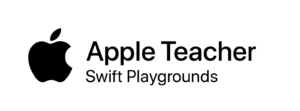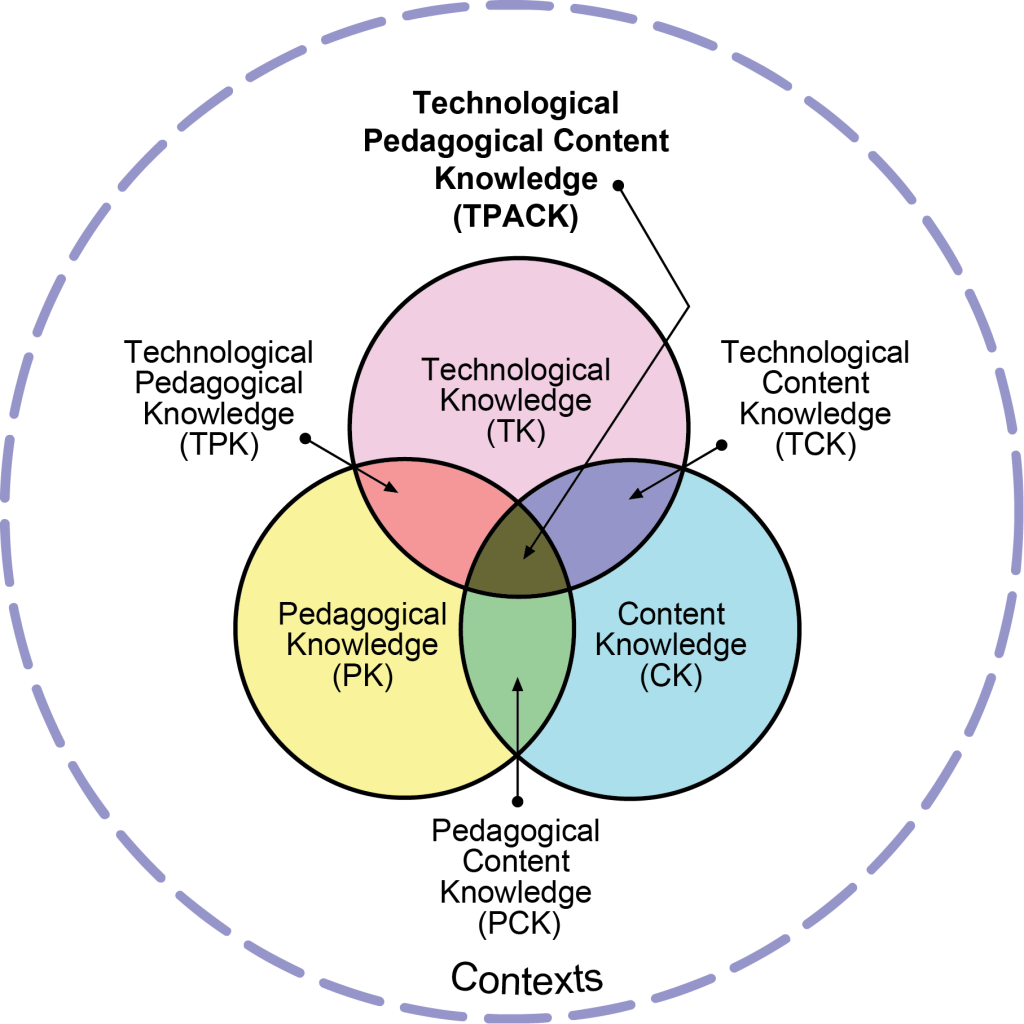Schmidt et al. (2009) present a very detailed study which resulted in the creation of a statistical model to quantify Technological Pedagogical Content Knowledge in future teachers. According to tpack.org “Technological Pedagogical Content Knowledge (TPACK) is a framework that identifies the knowledge teachers need to teach effectively with technology”. Below is a graphic representation of the TPACK components.
This is an extremely relevant construct for the K-12 classroom in that it can help prepare future teachers in the effective implementation of educational technology. Having a reference point for preservice teachers can help guide professional development to better prepare them for the “21st Century Classroom”.
Having a tool to quantify and help develop TPACK is extremely valuable for educational technology. Lack of professional development is often cited in the literature as a reason for inconsistent implementation of educational technology.
Whether TPACK level improvement can resolve all the barriers remains to be seen. Tsai and Chai (2012) offer a positive view:“We would like to highlight that the key essence of TPACK lies in the dynamic creation of knowledge and practice by teachers when they are confronted with the advancement of ICT and its associated pedagogical affordances. We term this capacity as “design thinking”. It moves beyond the TPACK knowledge perspective, which tends to be associated with codified/justified true beliefs, into the design mode of knowing. Design thinking seeks to change and improve current situations and create what is desired. It may therefore tackle both first and second order barriers as it treats all barriers as problems that need to be tackled and resolved through human creative thinking”.
While professional development is a critical factor in the efficacy of any technology implementation, it is not the only issue educational technology faces. Ertmer and Ottenbreit-Leftwich (2010) identify an important dynamic that is also a barrier to the implementation of educational technology: “For many teachers, possessing the relevant knowledge, confidence, and beliefs is enough to empower them to integrate technology into their classrooms in meaningful ways. We probably all know teachers who have managed to be successful users, despite facing multiple barriers, including the lack of support (Ertmer, Gopalakrisnan, & Ross, 2001). Yet, for the vast majority of teachers, this is still not enough, as research indicates that innovative teachers are easily overpowered by pressures to conform (Roehrig et al., 2007). “Teachers are not ‘free agents’ and their use of ICT for teaching and learning depends on the interlocking cultural, social, and organizational contexts in which they live and work” (Somekh, 2008, p.450). And, unfortunately, for most, the culture to which they must conform has not adopted a definition of effective teaching that includes the notion of technology as an important tool for facilitating student learning”.
Quantifying and addressing TPACK for preservice teachers is a significant step in the future success of teachers’ effectively implementing educational technology. I would suggest that the TPACK framework studies be extended to include not only more advanced students but also current inservice teachers and administrators. Subsequent follow up studies with the same participants would also prove to be extremely valuable.
Until all educators and administrators have a reasonable TPACK level, there will be barriers to effective implementation and use of technology in education.
References:
Denise A. Schmidt, Evrim Baran, Ann D. Thompson, Punya Mishra, Matthew J. Koehler & Tae S. Shin (2009) Technological Pedagogical Content Knowledge (TPACK), Journal of Research on Technology in Education, 42:2, 123-149, DOI: 10.1080/15391523.2009.10782544
Peggy A. Ertmer & Anne T. Ottenbreit-Leftwich (2010) Teacher Technology Change, Journal of Research on Technology in Education, 42:3, 255-284, DOI: 10.1080/15391523.2010.10782551
Ertmer, P. A., Gopalakrishnan, S., & Ross, E. M. (2001). Technology-using teachers: Comparing perceptions of exemplary technology use to best practice. Journal of Research on Technology in Education, 33(5).
Roehrig, G. H., Kruse, R. A., & Kern, A. (2007). Teacher and school characteristics and their influence on curriculum implementation. Journal of Research in Science Teaching, 44, 883-907.
Somekh, B. (2008). Factors affecting teachers’ pedagogical adoption of ICT. In J. Voogt & G. Knezek (Eds.), International handbook of information technology in primary and secondary education (pp. 449-460). New York: Springer.
Tsai, C. C. & Chai, C. S. (2012). The “third”-order barrier for technology-integration instruction: Implications for teacher education. In C. P. Lim & C. S. Chai (Eds), Building the ICT capacity of the next generation of teachers in Asia. Australasian Journal of Educational Technology, 28(Special issue, 6), 1057-1060. http://www.ascilite.org.au/ajet/ajet28/tsai-cc.html


